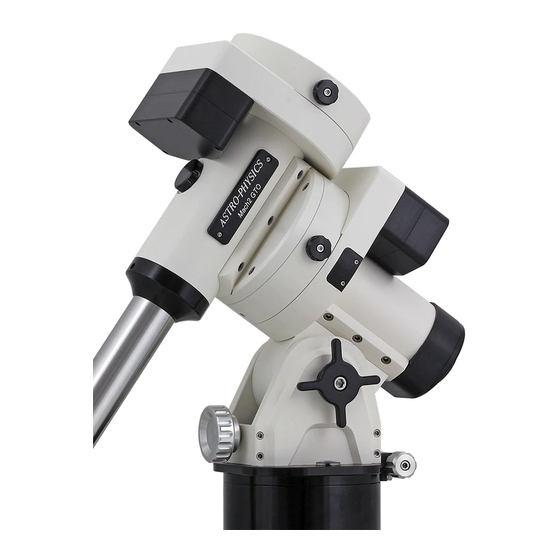ASTRO-PHYSICS 900 German Equatorial Manuale di avvio rapido
Sfoglia online o scarica il pdf Manuale di avvio rapido per Accessories ASTRO-PHYSICS 900 German Equatorial. ASTRO-PHYSICS 900 German Equatorial 2. Polar alignment telescope and illuminator (pasill)
Anche per ASTRO-PHYSICS 900 German Equatorial: Manuale (12 pagine), Manuale (3 pagine)

Replacing the Latitude Adjuster of 900 German Equatorial
9ALKIT part list
S900AA-A
Altitude Adjuster Brace Assembly with Altitude Knob, Threaded Rod and Tommy Bar
four ¼-20 x 5/8" flathead socket cap screws
9ALBKIT part list
M9060-A
Altitude Adjuster Brace
Four ¼-20 x 5/8" flathead socket cap screws
Mounts that can be upgraded:
All 900 mounts that have been produced, i.e. models designated as HDA (Quartz Controller), QMD (Quartz Micro-Drive
Controller), SMD (Servo – non-go-to) and GTO (go-to).
Replacing the Latitude Adjuster
Do not attempt this with the telescope or declination axis attached. You should be working with the RA axis only. Before
attempting to remove the altitude adjuster bar, you must raise the RA axis to its maximum altitude position, and then tighten
the altitude-locking knob on the motor/gear housing side. This will prevent any downward movement of the polar axis during
positioning of the altitude adjuster bar. ( See #'s 3 & 4 below.) Remove the current altitude adjuster bar from your mount.
9ALBKIT – Since you have just purchased the brace (not the assembly), you will have to install the original components onto
the new brace. Do not attempt to disassemble the brass component. Instead, loosen the setscrew on the large black knob
and thread the knob from the rod. Then, remove the threaded rod.
9ALKIT – Your assembly is complete. You do not need any parts from the original assembly.
The directions below come from the 900 manual and can be used as a guide for initial installation or changing the position in
the future. Please read the instructions through and apply to your situation.
The latitude range of the 900 mount is approximately 20-68 degrees. Since most astronomers typically observe within one
latitude range, this adjustment is made just once, if at all. We suggest that before you travel to an observing location,
determine the approximate latitude of your observing site and make the appropriate rough adjustment. If you live in or plan to
travel to locations that are 0-20 degrees latitude, we recommend our wedge (900WDG).
The four positions for the altitude adjustments have the following approximate ranges:
52 degrees to 68 degrees latitude - top position
41 degrees to 59 degrees latitude - second position
30 degrees to 45 degrees latitude - third position
20 degrees to 34 degrees latitude - bottom position
How to change the position of the altitude adjuster
1.
Use only the R.A. axis. DO NOT attempt to make
these adjustments with the declination axis in
place and certainly not with an instrument fully
mounted.
2.
Loosen both altitude-locking knobs about 1 turn.
3.
Locate the side of the polar axis that does not
have the motor/gear housing box. Loosen (about
1 turn) the polar axis pivot screw and altitude
adjuster bar fixing screws on this side only. With
your hand, push the polar axis upwards so that
the altitude-locking knobs are positioned at the
top of the altitude slot (this is the maximum
ASTRO-PHYSICS
1
